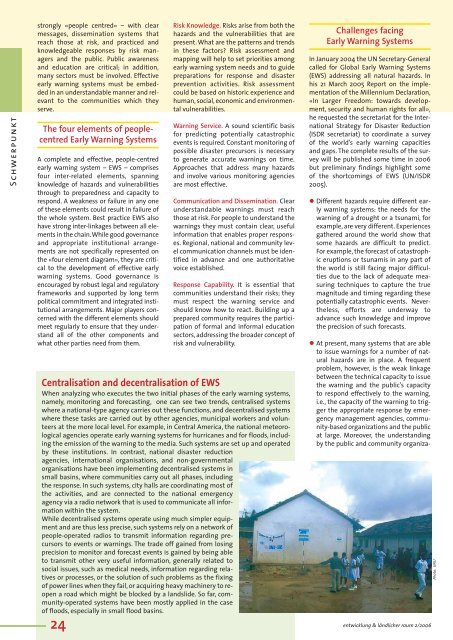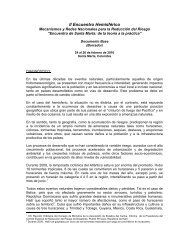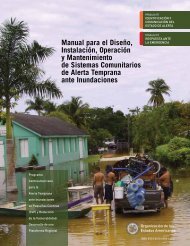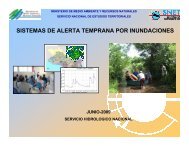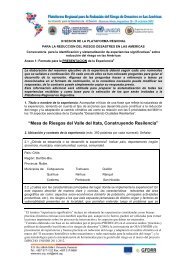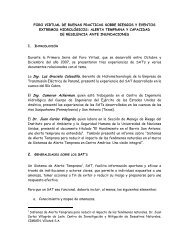Early Warning Systems in the context of Disaster Risk ... - unisdr
Early Warning Systems in the context of Disaster Risk ... - unisdr
Early Warning Systems in the context of Disaster Risk ... - unisdr
You also want an ePaper? Increase the reach of your titles
YUMPU automatically turns print PDFs into web optimized ePapers that Google loves.
Schwerpunkt<br />
strongly «people centred» – with clear<br />
messages, dissem<strong>in</strong>ation systems that<br />
reach those at risk, and practiced and<br />
knowledgeable responses by risk managers<br />
and <strong>the</strong> public. Public awareness<br />
and education are critical; <strong>in</strong> addition,<br />
many sectors must be <strong>in</strong>volved. Effective<br />
early warn<strong>in</strong>g systems must be embedded<br />
<strong>in</strong> an understandable manner and relevant<br />
to <strong>the</strong> communities which <strong>the</strong>y<br />
serve.<br />
The four elements <strong>of</strong> peoplecentred<br />
<strong>Early</strong> <strong>Warn<strong>in</strong>g</strong> <strong>Systems</strong><br />
A complete and effective, people-centred<br />
early warn<strong>in</strong>g system – EWS – comprises<br />
four <strong>in</strong>ter-related elements, spann<strong>in</strong>g<br />
knowledge <strong>of</strong> hazards and vulnerabilities<br />
through to preparedness and capacity to<br />
respond. A weakness or failure <strong>in</strong> any one<br />
<strong>of</strong> <strong>the</strong>se elements could result <strong>in</strong> failure <strong>of</strong><br />
<strong>the</strong> whole system. Best practice EWS also<br />
have strong <strong>in</strong>ter-l<strong>in</strong>kages between all elements<br />
<strong>in</strong> <strong>the</strong> cha<strong>in</strong>.While good governance<br />
and appropriate <strong>in</strong>stitutional arrangements<br />
are not specifically represented on<br />
<strong>the</strong> «four element diagram», <strong>the</strong>y are critical<br />
to <strong>the</strong> development <strong>of</strong> effective early<br />
warn<strong>in</strong>g systems. Good governance is<br />
encouraged by robust legal and regulatory<br />
frameworks and supported by long term<br />
political commitment and <strong>in</strong>tegrated <strong>in</strong>stitutional<br />
arrangements. Major players concerned<br />
with <strong>the</strong> different elements should<br />
meet regularly to ensure that <strong>the</strong>y understand<br />
all <strong>of</strong> <strong>the</strong> o<strong>the</strong>r components and<br />
what o<strong>the</strong>r parties need from <strong>the</strong>m.<br />
Centralisation and decentralisation <strong>of</strong> EWS<br />
When analyz<strong>in</strong>g who executes <strong>the</strong> two <strong>in</strong>itial phases <strong>of</strong> <strong>the</strong> early warn<strong>in</strong>g systems,<br />
namely, monitor<strong>in</strong>g and forecast<strong>in</strong>g, one can see two trends, centralised systems<br />
where a national-type agency carries out <strong>the</strong>se functions, and decentralised systems<br />
where <strong>the</strong>se tasks are carried out by o<strong>the</strong>r agencies, municipal workers and volunteers<br />
at <strong>the</strong> more local level. For example, <strong>in</strong> Central America, <strong>the</strong> national meteorological<br />
agencies operate early warn<strong>in</strong>g systems for hurricanes and for floods, <strong>in</strong>clud<strong>in</strong>g<br />
<strong>the</strong> emission <strong>of</strong> <strong>the</strong> warn<strong>in</strong>g to <strong>the</strong> media. Such systems are set up and operated<br />
by <strong>the</strong>se <strong>in</strong>stitutions. In contrast, national disaster reduction<br />
agencies, <strong>in</strong>ternational organisations, and non-governmental<br />
organisations have been implement<strong>in</strong>g decentralised systems <strong>in</strong><br />
small bas<strong>in</strong>s, where communities carry out all phases, <strong>in</strong>clud<strong>in</strong>g<br />
<strong>the</strong> response. In such systems, city halls are coord<strong>in</strong>at<strong>in</strong>g most <strong>of</strong><br />
<strong>the</strong> activities, and are connected to <strong>the</strong> national emergency<br />
agency via a radio network that is used to communicate all <strong>in</strong>formation<br />
with<strong>in</strong> <strong>the</strong> system.<br />
While decentralised systems operate us<strong>in</strong>g much simpler equipment<br />
and are thus less precise, such systems rely on a network <strong>of</strong><br />
people-operated radios to transmit <strong>in</strong>formation regard<strong>in</strong>g precursors<br />
to events or warn<strong>in</strong>gs. The trade <strong>of</strong>f ga<strong>in</strong>ed from los<strong>in</strong>g<br />
precision to monitor and forecast events is ga<strong>in</strong>ed by be<strong>in</strong>g able<br />
to transmit o<strong>the</strong>r very useful <strong>in</strong>formation, generally related to<br />
social issues, such as medical needs, <strong>in</strong>formation regard<strong>in</strong>g relatives<br />
or processes, or <strong>the</strong> solution <strong>of</strong> such problems as <strong>the</strong> fix<strong>in</strong>g<br />
<strong>of</strong> power l<strong>in</strong>es when <strong>the</strong>y fail, or acquir<strong>in</strong>g heavy mach<strong>in</strong>ery to reopen<br />
a road which might be blocked by a landslide. So far, community-operated<br />
systems have been mostly applied <strong>in</strong> <strong>the</strong> case<br />
<strong>of</strong> floods, especially <strong>in</strong> small flood bas<strong>in</strong>s.<br />
24<br />
<strong>Risk</strong> Knowledge. <strong>Risk</strong>s arise from both <strong>the</strong><br />
hazards and <strong>the</strong> vulnerabilities that are<br />
present. What are <strong>the</strong> patterns and trends<br />
<strong>in</strong> <strong>the</strong>se factors <strong>Risk</strong> assessment and<br />
mapp<strong>in</strong>g will help to set priorities among<br />
early warn<strong>in</strong>g system needs and to guide<br />
preparations for response and disaster<br />
prevention activities. <strong>Risk</strong> assessment<br />
could be based on historic experience and<br />
human, social, economic and environmental<br />
vulnerabilities.<br />
<strong>Warn<strong>in</strong>g</strong> Service. A sound scientific basis<br />
for predict<strong>in</strong>g potentially catastrophic<br />
events is required. Constant monitor<strong>in</strong>g <strong>of</strong><br />
possible disaster precursors is necessary<br />
to generate accurate warn<strong>in</strong>gs on time.<br />
Approaches that address many hazards<br />
and <strong>in</strong>volve various monitor<strong>in</strong>g agencies<br />
are most effective.<br />
Communication and Dissem<strong>in</strong>ation. Clear<br />
understandable warn<strong>in</strong>gs must reach<br />
those at risk. For people to understand <strong>the</strong><br />
warn<strong>in</strong>gs <strong>the</strong>y must conta<strong>in</strong> clear, useful<br />
<strong>in</strong>formation that enables proper responses.<br />
Regional, national and community level<br />
communication channels must be identified<br />
<strong>in</strong> advance and one authoritative<br />
voice established.<br />
Response Capability. It is essential that<br />
communities understand <strong>the</strong>ir risks; <strong>the</strong>y<br />
must respect <strong>the</strong> warn<strong>in</strong>g service and<br />
should know how to react. Build<strong>in</strong>g up a<br />
prepared community requires <strong>the</strong> participation<br />
<strong>of</strong> formal and <strong>in</strong>formal education<br />
sectors, address<strong>in</strong>g <strong>the</strong> broader concept <strong>of</strong><br />
risk and vulnerability.<br />
Challenges fac<strong>in</strong>g<br />
<strong>Early</strong> <strong>Warn<strong>in</strong>g</strong> <strong>Systems</strong><br />
In January 2004 <strong>the</strong> UN Secretary-General<br />
called for Global <strong>Early</strong> <strong>Warn<strong>in</strong>g</strong> <strong>Systems</strong><br />
(EWS) address<strong>in</strong>g all natural hazards. In<br />
his 21 March 2005 Report on <strong>the</strong> implementation<br />
<strong>of</strong> <strong>the</strong> Millennium Declaration,<br />
«In Larger Freedom: towards development,<br />
security and human rights for all»,<br />
he requested <strong>the</strong> secretariat for <strong>the</strong> International<br />
Strategy for <strong>Disaster</strong> Reduction<br />
(ISDR secretariat) to coord<strong>in</strong>ate a survey<br />
<strong>of</strong> <strong>the</strong> world’s early warn<strong>in</strong>g capacities<br />
and gaps. The complete results <strong>of</strong> <strong>the</strong> survey<br />
will be published some time <strong>in</strong> 2006<br />
but prelim<strong>in</strong>ary f<strong>in</strong>d<strong>in</strong>gs highlight some<br />
<strong>of</strong> <strong>the</strong> shortcom<strong>in</strong>gs <strong>of</strong> EWS (UN/ISDR<br />
2005).<br />
Different hazards require different early<br />
warn<strong>in</strong>g systems: <strong>the</strong> needs for <strong>the</strong><br />
warn<strong>in</strong>g <strong>of</strong> a drought or a tsunami, for<br />
example, are very different. Experiences<br />
ga<strong>the</strong>red around <strong>the</strong> world show that<br />
some hazards are difficult to predict.<br />
For example, <strong>the</strong> forecast <strong>of</strong> catastrophic<br />
eruptions or tsunamis <strong>in</strong> any part <strong>of</strong><br />
<strong>the</strong> world is still fac<strong>in</strong>g major difficulties<br />
due to <strong>the</strong> lack <strong>of</strong> adequate measur<strong>in</strong>g<br />
techniques to capture <strong>the</strong> true<br />
magnitude and tim<strong>in</strong>g regard<strong>in</strong>g <strong>the</strong>se<br />
potentially catastrophic events. Never<strong>the</strong>less,<br />
efforts are underway to<br />
advance such knowledge and improve<br />
<strong>the</strong> precision <strong>of</strong> such forecasts.<br />
At present, many systems that are able<br />
to issue warn<strong>in</strong>gs for a number <strong>of</strong> natural<br />
hazards are <strong>in</strong> place. A frequent<br />
problem, however, is <strong>the</strong> weak l<strong>in</strong>kage<br />
between <strong>the</strong> technical capacity to issue<br />
<strong>the</strong> warn<strong>in</strong>g and <strong>the</strong> public’s capacity<br />
to respond effectively to <strong>the</strong> warn<strong>in</strong>g,<br />
i.e., <strong>the</strong> capacity <strong>of</strong> <strong>the</strong> warn<strong>in</strong>g to trigger<br />
<strong>the</strong> appropriate response by emergency<br />
management agencies, community-based<br />
organizations and <strong>the</strong> public<br />
at large. Moreover, <strong>the</strong> understand<strong>in</strong>g<br />
by <strong>the</strong> public and community organiza-<br />
entwicklung & ländlicher raum 2/2006<br />
Photo: UNU


